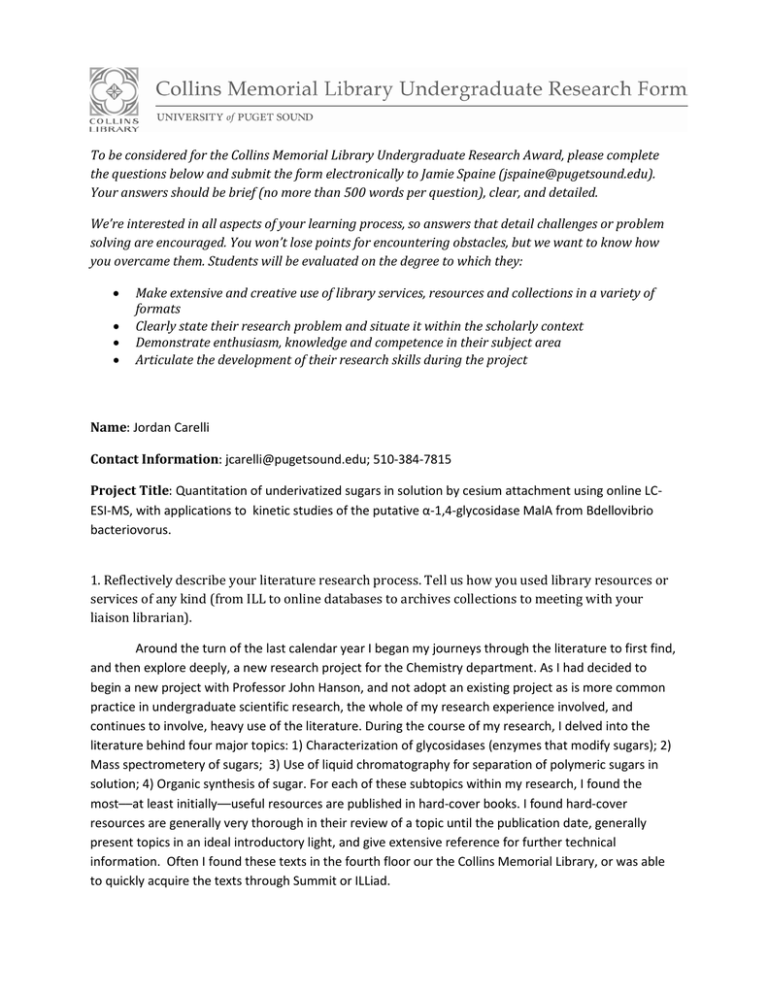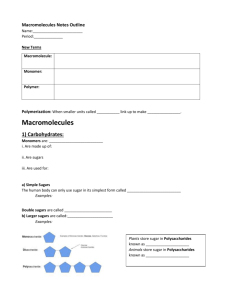To be considered for the Collins Memorial Library Undergraduate Research... the questions below and submit the form electronically to Jamie...
advertisement

To be considered for the Collins Memorial Library Undergraduate Research Award, please complete the questions below and submit the form electronically to Jamie Spaine (jspaine@pugetsound.edu). Your answers should be brief (no more than 500 words per question), clear, and detailed. We’re interested in all aspects of your learning process, so answers that detail challenges or problem solving are encouraged. You won’t lose points for encountering obstacles, but we want to know how you overcame them. Students will be evaluated on the degree to which they: • • • • Make extensive and creative use of library services, resources and collections in a variety of formats Clearly state their research problem and situate it within the scholarly context Demonstrate enthusiasm, knowledge and competence in their subject area Articulate the development of their research skills during the project Name: Jordan Carelli Contact Information: jcarelli@pugetsound.edu; 510-384-7815 Project Title: Quantitation of underivatized sugars in solution by cesium attachment using online LCESI-MS, with applications to kinetic studies of the putative α-1,4-glycosidase MalA from Bdellovibrio bacteriovorus. 1. Reflectively describe your literature research process. Tell us how you used library resources or services of any kind (from ILL to online databases to archives collections to meeting with your liaison librarian). Around the turn of the last calendar year I began my journeys through the literature to first find, and then explore deeply, a new research project for the Chemistry department. As I had decided to begin a new project with Professor John Hanson, and not adopt an existing project as is more common practice in undergraduate scientific research, the whole of my research experience involved, and continues to involve, heavy use of the literature. During the course of my research, I delved into the literature behind four major topics: 1) Characterization of glycosidases (enzymes that modify sugars); 2) Mass spectrometery of sugars; 3) Use of liquid chromatography for separation of polymeric sugars in solution; 4) Organic synthesis of sugar. For each of these subtopics within my research, I found the most––at least initially––useful resources are published in hard-cover books. I found hard-cover resources are generally very thorough in their review of a topic until the publication date, generally present topics in an ideal introductory light, and give extensive reference for further technical information. Often I found these texts in the fourth floor our the Collins Memorial Library, or was able to quickly acquire the texts through Summit or ILLiad. In particular, a series of hard-copy volumes in the stacks at Collins Memorial Library entitled Methods in Enzymology provided a great starting point for finding first references on glycosidase characterization. Methods in Enzymology serves as a sort of standard reference of methods for studying enzymes, and each article is followed by extensive references to other relevant studies. Other particularly useful texts included hard-cover publications of the Journal of Chromatography, Advances in Carbohydrate Chemistry and Biochemistry, and several comprehensive texts on the organic synthesis of sugars. These texts always lead to relevant journal article citations, which are generally necessary to find when practicing an experimental science, as the original articles include all the valuable experimental details and specific results. I also searched for “point” journal articles, from which I derived many other references, though PubMed, Google Scholar, and searches within the American Chemical Society plethora of online-accessible journals. Once I found a potentially useful article citation, I used the Collins Memorial Library Journal Locator to see if I could immediately find the article. If not, I entered the citation into ILLiad, and generally receive an electronic scan of the article within a few days, or at most a week or two. I also found back-referencing articles (“cited by”) through Google Scholar to be an effective method of finding newer articles that draw on those which I had already found useful. This method of literature research is iterative and only ended when I felt that I have covered a somewhat comprehensive historical study of a topic and that I could pursue the topic experimentally. This wasn’t quite as daunting as it sounds, as authors generally include sufficient background in introductions to at least understand, if not find references for, the history of a topic’s study. 2. Tell us about a challenge you faced during your literature research and how you overcame it. The most challenging references for me to find were organic syntheses. As I was generally seeking simple sugar derivatives that aren’t the topics of many modern research papers, online searching within Google Scholar, or the American Chemical Society generally returned irrelevant modern articles. Here, my research advisor John Hanson was extremely helpful in teaching me tricks to using a fantastic online resource, SciFinder. SciFinder allows for searches based on keyword, chemical structure, or reagents, and allowed me to find the obscure German synthesis preformed in the 1970’s that I needed. Furthermore, I think I initially undervalued the hardcover texts on organic synthesis available in the Collins Library. These continually proved invaluable resources, especially for basic transformations that aren’t the spotlight of modern research. 3. How does your research contribute to the scholarly conversation in your field? What is the significance of your research, in layperson’s terms? The ultimate goal of my project is to contextualize the presence of an anomalous enzyme within the genome of the bacteria-eating-bacteria Bdellovibrio bacteriovorous. Early studies on the bacteria’s metabolism showed that it did not utilize sugars from it’s prey––only fats, proteins, and nucleic acids. When the bacteria’s genome was sequenced in 2005, the sequence of three genes appeared to be about 60% similar to genes in other organisms that code for sugar-metabolizing enzymes. One of these is MalA, a putative α-1,4-glycosidase, the focus of my research. Without an obvious use for an enzyme that metabolizes sugars, our goal, set out by Mark Martin in the Biology department, is to discover the precise function of the enzyme so that we might begin to understand or discover a previously misunderstood or unknown part of the bacteria’s metabolic life. The primary focus of my summer work on the project was to establish a method for quantitating the sugar content of a solution––this is the first step in being able to understand in what manner an enzyme might change sugars. Traditionally, similar enzymes have been studied by analyzing the concentration of the most simple sugar unit, glucose, by a multi-step enzymatic-chemical reaction that allows glucose concentration to be determined. I am working to develop a highly sensitive method with liquid chromatography coupled to mass spectrometery (LC MS) to quantitate concentrations of glucose and polymers of glucose in solution. Variations of this technique have been used to study the glucose concentration of a diabetic’s urine, or sugar composition of fruit juices. With an LC MS method tailored to the detection of probable substrates and products of MalA, we will be able to precisely and conveniently characterize its activity, which is requisite to understanding the enzyme’s function. Beyond the immediate in-house application of this LC MS method to Bdellovibrio’s metabolism, the same methodology should be useful for the convenient study of other sugar-associated enzymes, or analysis of any sugar-containing solution. I will be continuing this work as my senior thesis, and am very hopeful that I will soon have the LC MS method working and verified for use in characterization studies. I will also continue some preliminary organic syntheses that I began this summer to produce substrate derivatives for the enzyme. I will assay MalA with the completed substrate derivatives for changes in activity using the LC MS method, and begin to elucidate how the enzyme interacts with its substrate. Understanding enzymesubstrate interactions will help us place the function of the enzyme within the context of the greater organism.

